"The Dawn of Holographic Storage: A New Era in Data Preservation"
Introduction: In an era where data is the new oil, the quest for efficient, high-capacity storage solutions is relentless. Enter holographic storage—a technology that promises to revolutionize the way we store and retrieve data. This article delves into the fascinating world of holographic storage, tracing its history, current developments, and potential impact on the tech market.

A Glimpse into the Past: The Genesis of Holographic Storage
Holographic storage is not a new concept. The idea was first proposed in the early 1960s, following the invention of the laser. Early prototypes were able to store data in three dimensions, offering significantly higher storage densities than traditional magnetic or optical storage. However, the technology was hampered by high costs and technical challenges, relegating it to the realm of science fiction for several decades.
The Resurgence: Holographic Storage in the 21st Century
Fast forward to the present day, and holographic storage is experiencing a resurgence. Advances in laser technology and materials science have made it possible to create practical, affordable holographic storage devices. Companies like InPhase Technologies and Akonia Holographics are leading the charge, developing systems that can store terabytes of data on a single disc.
The Mechanics: How Holographic Storage Works
Holographic storage works by using a laser to create a hologram of the data, which is then stored on a photosensitive medium. The data can be retrieved by illuminating the hologram with a reference beam, which reconstructs the original data. This allows for incredibly high storage densities—up to 1,000 times greater than a traditional hard drive.
The Market Impact: A New Frontier in Data Storage
The potential market impact of holographic storage is immense. With the explosion of big data, there is a growing need for high-capacity, high-speed storage solutions. Holographic storage could fill this gap, offering a cost-effective alternative to traditional storage methods. While it’s still early days, analysts predict that the holographic storage market could be worth billions in the coming years.
The Future: What’s Next for Holographic Storage
The future of holographic storage looks bright. Researchers are already working on next-generation systems that could offer even higher storage densities and faster data retrieval times. Meanwhile, the advent of quantum computing could open up new possibilities for holographic storage, potentially catapulting it into the mainstream.
In conclusion, holographic storage represents a fascinating intersection of physics, materials science, and information technology. While there are still challenges to overcome, the potential benefits are too great to ignore. As we continue to generate and consume data at an unprecedented rate, holographic storage could be the key to preserving our digital heritage for generations to come.





